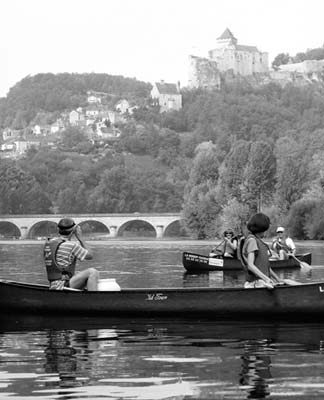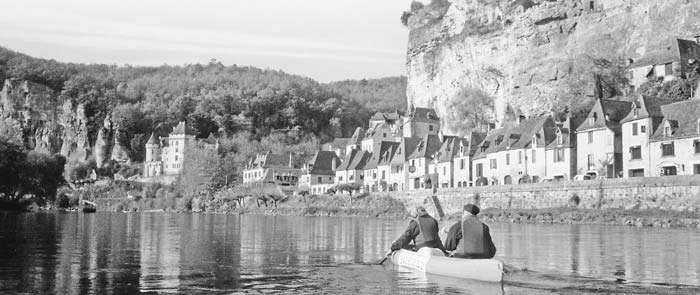Rick Steves'
SNAPSHOT
Dordogne
Rick Steves & Steve Smith
INTRODUCTION
This Snapshot guide, excerpted from my guidebook Rick Steves France, introduces you to the Dordogne, an under-the-radar region of France. There are no big cities here. Instead, youll plunge into traditional villages with cobblestone lanes and lively markets. You can sample foie gras along the medieval streets of Sarlat and scramble over the riverside Chteau de Beynacone of the most monumental castles in France. Float down the Beynac River in a canoe or visit colorful prehistoric cave paintings at Grotte de Font-de-Gaume. Side-trip to an idyllic wine townSt. Emilion; then make a pilgrimage to one of Europes top religious sitesRocamadour.
To help you have the best trip possible, Ive included the following topics in this book:
Planning Your Time, with advice on how to make the most of your limited time
Orientation, including tourist information (abbreviated as TI), tips on public transportation, local tour options, and helpful hints
Sights with ratings:
Dont miss
Try hard to see
Worthwhile if you can make it
No ratingWorth knowing about
Sleeping and Eating, with good-value recommendations in every price range
Connections, with tips on trains, buses, and driving
Practicalities, near the end of this book, has information on money, phoning, hotel reservations, transportation, and more, plus French survival phrases.
To travel smartly, read this little book in its entirety before you go. Its my hope that this guide will make your trip more meaningful and rewarding. Traveling like a temporary local, youll get the absolute most out of every mile, minute, and dollar.
Bon voyage!
Rick Steves
Sarlat Dordogne River Valley Cro-Magnon Caves Oradour-sur-Glane St-Emilion Rocamadour Lot River Valley
The Dordogne River Valley is a rich brew of natural and man-made beauty. Walnut orchards, tobacco plants, sunflowers, and cornfields carpet the valley, while stone fortresses patrol the cliffs above. During much of the on-again, off-again Hundred Years War (when this region was called the Prigord), this strategic riverso peaceful todayseparated warring Britain and France. Todays Dordogne River carries more travelers than goods, as the regions economy relies heavily on tourism.
The joys of the Dordogne include rock-sculpted villages, fertile farms surrounding I-should-retire-here cottages, memory-card-gobbling vistas, lazy canoe rides, and a local cuisine worth loosening your belt for. But its big draw is its amazing cache of prehistoric artifacts. Limestone caves decorated with prehistoric artwork litter the Dordogne region.
Planning Your Time
Although tourists inundate the region in the summer, the Dordognes charm is protected by its relative inaccessibility. Given the time it takes to get here, Id allow a minimum of two nights (ideally three) and most of two days...or Id skip it. Your sightseeing obligations, in order of priority, are as follows: prehistoric cave art; the Dordogne River Valley, nearby villages, and castles; the town of Sarlat; and, if you have a bit more time, the less-traveled Lot River Valley (most efficiently viewed when heading to or from the south). Wine lovers work in a pilgrimage to St-Emilion, two hours west of Sarlat.
If youre connecting the Dordogne with the Loire region by car, the fastest path is on the A-20 autoroute (exit at Souillac for Sarlat and nearby villages). Break up your trip from the north by stopping in Oradour-sur-Glane. If you need to spend the night in this area, consider tiny Mortemart. If youre connecting the Dordogne and Carcassonne, explore the Lot River Valley on your way south. If heading west, taste the Bordeaux wine regions prettiest town, St-Emilion.
Those serious about visiting the Dordognes best caves (especially with a relatively rare English-speaking tour) need to plan carefully and book ahead when possible.
The following three-day itinerary is designed for drivers, but its doableif youre determinedby taxi rides, a canoe trip (the best way to see the Dordogne regardless of whether youve got a car), and a minivan tour.
Day 1: Enjoy a morning in Sarlat (ideally on a market daySat or Wed), then spend the afternoon on a canoe trip, with time at the days end to explore Beynac and Castelnaud. If its not market day in Sarlat, do the canoe trip, Beynac, and Castelnaud first, and enjoy the late afternoon and evening in Sarlat. (Because the towns essential sights are outdoors, my Sarlat self-guided walk works great after dinner.) The sensational views from Castelnauds castle and Domme are best in the morning; visit Beynacs castle or viewpoint late in the day for the best light. With a little lead time, canoe-rental companies can pick up non-drivers in Sarlat. Taxis are reasonable between Sarlat and the river villages.

Day 2: Drivers can make an early trip to their cave of choice to try to secure tickets for the day (I prefer Grotte de Font-de-Gaume and Grotte de Rouffignac, but neither take reservations). Once thats sorted out, head to Lascaux II (the best cave art intro in the area, even though its a replicamake sure to reserve ahead of time). Then follow the scenic Vzre River toward Les Eyzies-de-Tayac, stopping for lunch in idyllic little St-Lon before going on to the caves at La Roque St-Christophe (no reservations needed; doesnt close for lunch, unlike most other caves). In Les Eyzies-de-Tayac, visit the Prehistory Welcome Center and National Museum of Prehistory.
Without a car, this days full list of activities is only possible by taxi or excursion tour. By train, you can link Sarlat and Les Eyzies-de-Tayac, though you have to transfer and some connections arent great.
Day 3: Head east and upriver to explore Rocamadour, Gouffre de Padirac, and storybook villages such as Carennac, Autoire, and Loubressac. And though Rocamadour is accessible by train and a short taxi ride, the rest of these places are feasible only with your own wheels, by taxi, or on an excursion tour.
Choosing a Home Base
Sarlat is the only viable solution for train travelers, but those with a car should consider sleeping riverside in La Roque-Gageac (a beautiful village with good hotels) or Beynac (a trs photogenic village with good chambres dhtes and hotels). For a grand chteau hotel experience that wont break the bank, sleep near the Lascaux caves at Chteau de la Fleunie (30 minutes north of Sarlat). For the best view hotel Ive found in the area, try Htel de lEsplanade in Domme. If youd rather frolic on a real farm, sleep near Les Eyzies-de-Tayac at Auberge Veyret. For a list of good chambres dhtes













